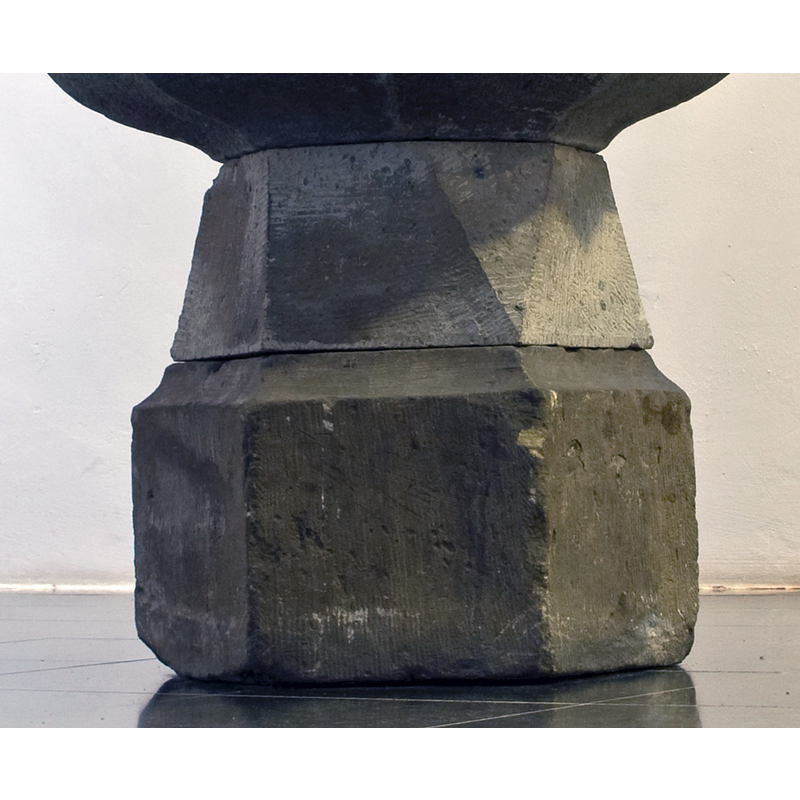Utrecht No. 2

Image copyright © Niels, 2009
CC-BY-SA-2.0
Results: 3 records
human figure - head - 4
view of font
Scene Description: as displayed in the Museum Catharijneconvent, Utrecht, in June 2009
Copyright Statement: Image copyright © Niels, 2009
Image Source: digital photograph taken 6 June 2009 by Niels [www.flickr.com/photos/73536601@N00/3604285563/] [accessed 26 December 2015]
Copyright Instructions: CC-BY-SA-2.0
view of font base
Scene Description: the two parts of the base are probably a composite arrangement, the original base missing
Copyright Statement: Image copyright © Niels, 2009
Image Source: edited detail of a digital photograph taken 6 June 2009 by Niels [www.flickr.com/photos/73536601@N00/3604285563/] [accessed 26 December 2015]
Copyright Instructions: CC-BY-SA-2.0
INFORMATION
FontID: 20264UTR
Object Type: Baptismal Font1
Museum and Inventory Number: Museum Catharijneconvent, Utrecht
Church/Chapel: [original location unknown]
Church Location: museum address: Lange Nieuwstraat 38, 3512 PH Utrecht, Netherlands -- Tel.: +31 30 231 3835
Country Name: Netherlands
Location: Utrecht
Directions to Site: The museum is located in the former Catharijneconvent, on Lange Nieuwstraat, in the centre of town
Font Location in Church: [in a museum]
Century and Period: 15th century [basin only] [composite font], Late Medieval
Workshop/Group/Artisan: Namur font
Font Notes:
Click to view
Baptismal font of a composite nature displayed in the Catharijneconvent, Utrecht; the basin belongs to the traditional design of fonts in this area, octagonal in shape with four human heads at 90-degree angles, with a double moulding decoration all around; it is displayed mounted on two polygonal blocks of stone that were not originally part of the font; the lower block even looks like a font basin itself.
A communication from Pol Herman to BSI (e-mail of 10 February 2022) dwells on the intricate movements of these two fonts that had a relation with Sint-Pieterskerk. On the Gothic Mosan baptismal font, today at the Museum Catharijneconvent Utrecht, it notes: Much more is known about the baptismal font that is currently in Museum Catharijneconvent (octagonal, also with four heads). What is special is that it originally stood in the Pieterskerk. In the 19th century, the font came into the hands of a collector and was subsequently purchased at an auction in 1876 by the Archbishop's Museum (Catharijneconvent). The Catharijneconvent loaned the font to the Catharinakerk, but it can now be viewed again in the Catharijneconvent. The following is written about the 'mask heads' on this baptismal font in the catalogue of the Catharijneconvent: the first has a close-fitting headgear and shows his teeth with a grin; the second, with a hanging lip, wears a hat that tapers upwards; the third, narrow-mouthed, has a cap, the end of which turns forward; the fourth, also looking serious, has a flattened round headgear at the front. It also includes information from a mid-19thC source, Kronijk van het historisch gezelschap te Utrecht, Volume 14, Veertiende jaargang, 1858, Derde serie, Vierde deel, Utrecht, Kemink en Zoon, 1858, in whichis written [English translation by Pol Herman]: In the house standing in Utrecht on the Kromme Nieuwe Gracht or St. Pieters Regenboog, district F. N° 372, on the other side of the water, and extending from the Gracht to the St. Pieterskerkhof, where is situated the access to the coach house, beyond the choir of St. Pieter, now the Waalse Kerk, belonging to and inhabited by Mrs. de Widow Cantzlaar, born van Eversdijk, recently has been found the basin of an old baptismal font in one of the vaulted cellars, which opens out to the Gracht. This stone object was thus imbedded in the cellar that its top edge was level with the floor, and the bowl formed an obnoxious trough for water, which remained in it with no run-out if it was not deliberately scooped out. The proprietor, wishing to change this, gave orders to excavate the stone, when it was found that the outside was chiselled and decorated with four faces. Brought up with too little care, or with too much roughness, the stone is torn around; it is now placed in the middle of the garden on a wooden pedestal, for the old stone pedestal has been searched in vain in the cellar. It is highly probable that this baptismal font belonged to the old St. Peter's Church. Of the house in which it was found there is no older title of transition than that of 1790; so there is no information to get out of it. According to tradition, it is said that this building would have borne the name of Cardinaalshuis; according to Mattheus de fundat. in praefat., quoted by N. van der Monde, in his description of the squares, streets, etc. of the City of Utrecht, Volume I , p. 252, that and other monastic houses, located within the ring ditch of St. Pieter, are formerly inhabited by the Lords of the Chapter. One can therefore guess that when the St. Peter's Church was evicted from all objects belonging to the Roman Catholic worship, the baptismal font was transferred to one of the Lord Canons and placed in the cellar, where it was buried early in the ground, since on the upper rim of the basin the wall of a wine trough was established. In and near St. Peter's Church unsuccessful attempts have been made to find the pedestal again; the baptistery was probably on the right side of the nave of the church, where there is still a bricked-in entrance, which would now lead to the house that is used as a nursery school by the French deacon. The font, made of blue Namur stone, is not very old because of the type of stone and of the finishing, and it belongs to the 14th or 15th century.
COORDINATES
UTM: 31U 645531 5772880
MEDIUM AND MEASUREMENTS
Material: stone, limestone (Namur) [basin only]
Font Shape: octagonal (mounted)
Basin Interior Shape: round
Basin Exterior Shape: octagonal
Drainage Notes: no lining

